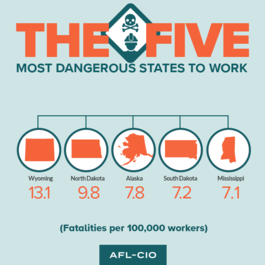
WASHINGTON (PAI) – On-the-job deaths and injuries increased slightly in 2014, the last full year for which data is available, the AFL-CIO reported. And a worker died on the job almost every other hour, 365 days a year.
In its 25th annual Death On The Job report, issued to mark Workers Memorial Day on April 28, the federation, using U.S. data, reported 3.4 deaths per 100,000 workers that year, up from 3.3 deaths per 100,000 the year before.
In absolute numbers, deaths also rose, to 4,821 dead in 2014 – 13 per day — from 4,585 the year before. That doesn’t count the estimated 50,000 former workers who died last year from job-related illnesses, such as silicosis and black lung disease.
The 224-page report breaks down the deaths, injuries and illnesses on the job by state, industry and occupation. But even the federation points out the data is incomplete, as worker deaths, and especially injuries, are vastly underreported.
And, as in past years, the report notes that fines the federal Occupational Safety and Health Administration (OSHA) or state OSHAs can impose on dangerous employers are too small to deter law-breakers. And the agencies are understaffed, with fewer than 2,000 state and federal OSHA inspectors, combined, for the country’s eight million workplaces.
“Working people should not have to risk their lives to make a living and support their families,” said AFL-CIO President Richard Trumka. “Yet every day, millions are forced to work with little to no safety protections while big businesses and corporations profit off our lives.”
Key findings in the report include:
- The most-fatal states to work in were Wyoming (13.1 deaths per 100,000 workers), North Dakota (9.8), Alaska (7.8), South Dakota (7.2) and Mississippi (7.1). The least-fatal states were Massachusetts (1.7), California (2.0) and New Jersey, Connecticut and Rhode Island (2.1). Though the report did not say so, 10 of the 11 worst states for worker deaths on the job – all but Alaska — were so-called “right to work” states, where unions are weaker and workers have less protection from bosses.
- Federal OSHA is so understaffed that it had 5.4 inspectors per million workers in 2014, a lower rate than the first year, 1974, its workforce size was even measured. And its budget is so small that it’s $3.71 “to protect the safety and health of each American worker,” the fed said.
State OSHAs aren’t much better. Their inspectors get to worksites an average of once every 97 years, the report calculates. For the feds, it’s an average of once every 145 years.
- Farming, fishing, logging, oil wells and refining and construction were again among the most-fatal occupations. Oil set a record for on-the-job deaths last year (144). And 899 (9.8 deaths per 100,000) construction workers died on the job last year, most of them from falls. That’s 19 percent of all job deaths nationwide, and up slightly from the year before.
- Almost eight million state and local government workers lacked OSHA coverage in 2014. By law, federal OSHA doesn’t cover state and local workers and almost half the states (24) don’t either. The largest groups of un-covered state and local workers were in Texas (1.59 million), Florida (892,713), Ohio (629,572) and Pennsylvania (587,500).
Government workers in Illinois, California, Oregon, Michigan, Minnesota, New York and 20 other states had state OSHA coverage, but 363,761 in Missouri and 218,456 in Kansas did not. And death rates overall for state workers (4.1per 100,000) and local workers (5.4) were higher than in private firms (3.2 per 100,000 workers).
- Older workers are more likely to die on the job (10.7 deaths per 100,000 workers). The 1,691 deaths of workers aged 55 or older set a record.
- Women were two-and-a-half times as likely to be murdered on the job last year as men. A total of 804 workers were murdered, including 367 women. That’s 19 percent of all female job deaths, compared to 8 percent of male job deaths.
- Contract workers were at particular risk. Since the federal government started counting those deaths on the job, they’ve risen from 542 in 2011 to 802 in 2014. More than half of them (416) were in construction, and most of those construction workers fell to death (290).
In hopeful developments, enforcement has increased under the Democratic Obama administration and job safety and health violation fines have risen, though median and average OSHA fines are still low. But last November, Congress raised them again, significantly.
The 2015 two-year budget agreement included a law increasing all federal civil fines and adjusting them for inflation. And, for the first time, it brought OSHA under the law. “Under the new law, OSHA is authorized to raise maximum penalties by approximately 80 percent, the amount of inflation since the last time OSHA penalties were raised in 1990,” the report notes.
“With these adjustments, the maximum penalty for a serious violation will increase from $7,000 to approximately $12,500 and the maximum penalty for a willful or repeat violation will increase from $70,000 to $125,000. The new penalty amounts must be implemented by regulation by July 1. State OSHA plans will be required to adjust their maximum penalties to conform to the new federal amounts,” Death on the Job reports.
“More than 532,000 workers now can say their lives have been saved since the passage of the Occupational Safety and Health Act of 1970, which promised workers in this country the right to a safe job,” the AFL-CIO report concludes. “Since the first Death on the Job report in 1992, there have been improvements in workplace protections, but at the same time some conditions have gotten worse. Too many workers remain at serious risk of injury, illness or death. There is much more work to be done.”
Photo: AFL-CIO










